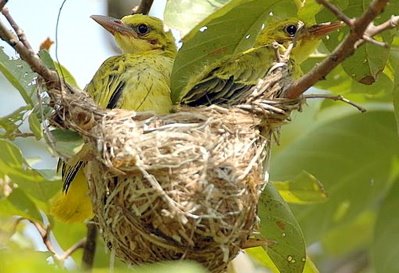The Black-naped Oriole (Oriolus chinensis) is a very distinctive bird of gardens and parks. Its bright yellow plumage and black nape make it easy to recognise. Its loud and fluty whistle is similarly distinctive. It is a common resident as well as a winter visitor.
The nest is a neat pouch-like structure made up of plant materials like thin pliable stems, roots, grass blades, slender twigs and fibres. These are intricately weaved together into a nest with parts of the rim firmly attached round slender supporting branches high up the tree. There are usually two bluish-white eggs covered with brown spots. It has been reported that the female is the one actively building the nest. In some species the male merely sits nearby, encouraging the female along. But we need to confirm such behaviour in this species.
Cheong Weng Chun came across such a nest in Taman Wetland Putrajaya situated north of the Malaysian capital city of Kuala Lumpur on 5th March 2006.
 There were two nestlings in the nest. This was the first time he actually saw the successful hatching of the eggs, his earlier two encounters were failures. Eight days later he saw the two nestlings grown into cute chicks ready to fledge. The very next day both young birds made their maiden flights. He spotted one on a tree some distance from the nest, with the parents feeding it regularly. “Where’s the other one?” he wondered.
There were two nestlings in the nest. This was the first time he actually saw the successful hatching of the eggs, his earlier two encounters were failures. Eight days later he saw the two nestlings grown into cute chicks ready to fledge. The very next day both young birds made their maiden flights. He spotted one on a tree some distance from the nest, with the parents feeding it regularly. “Where’s the other one?” he wondered.
Text and images by Cheong Weng Chun.










One Response
Hi,
If I want to use this post and pictures in my report, how should I cite this article? This article is posted by the admin but the text and images are by Cheong Weng Chun. So I don’t know how to cite this article in the APA style. Any help regarding this issue is much appreciated. Sorry for any inconveniences caused and thanks again.
wuweisiong